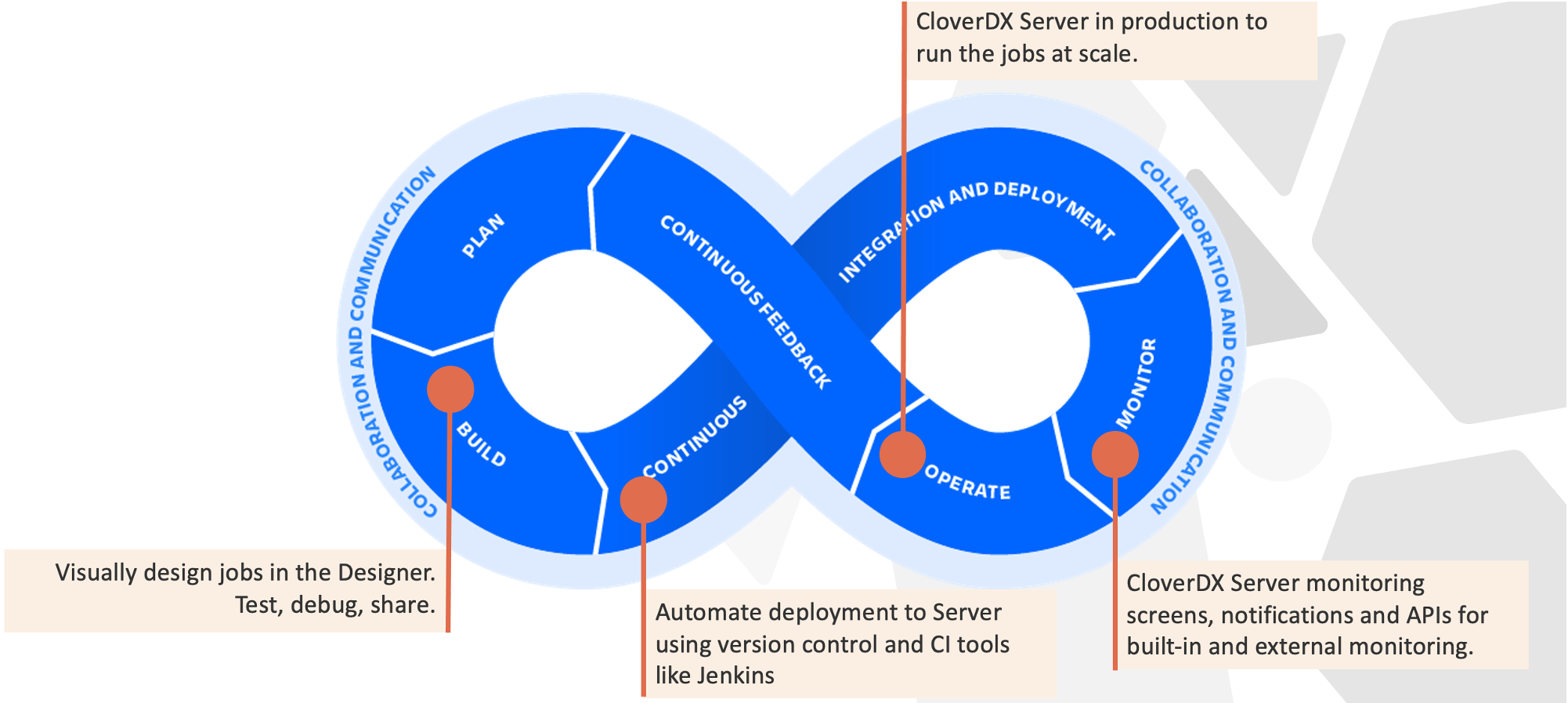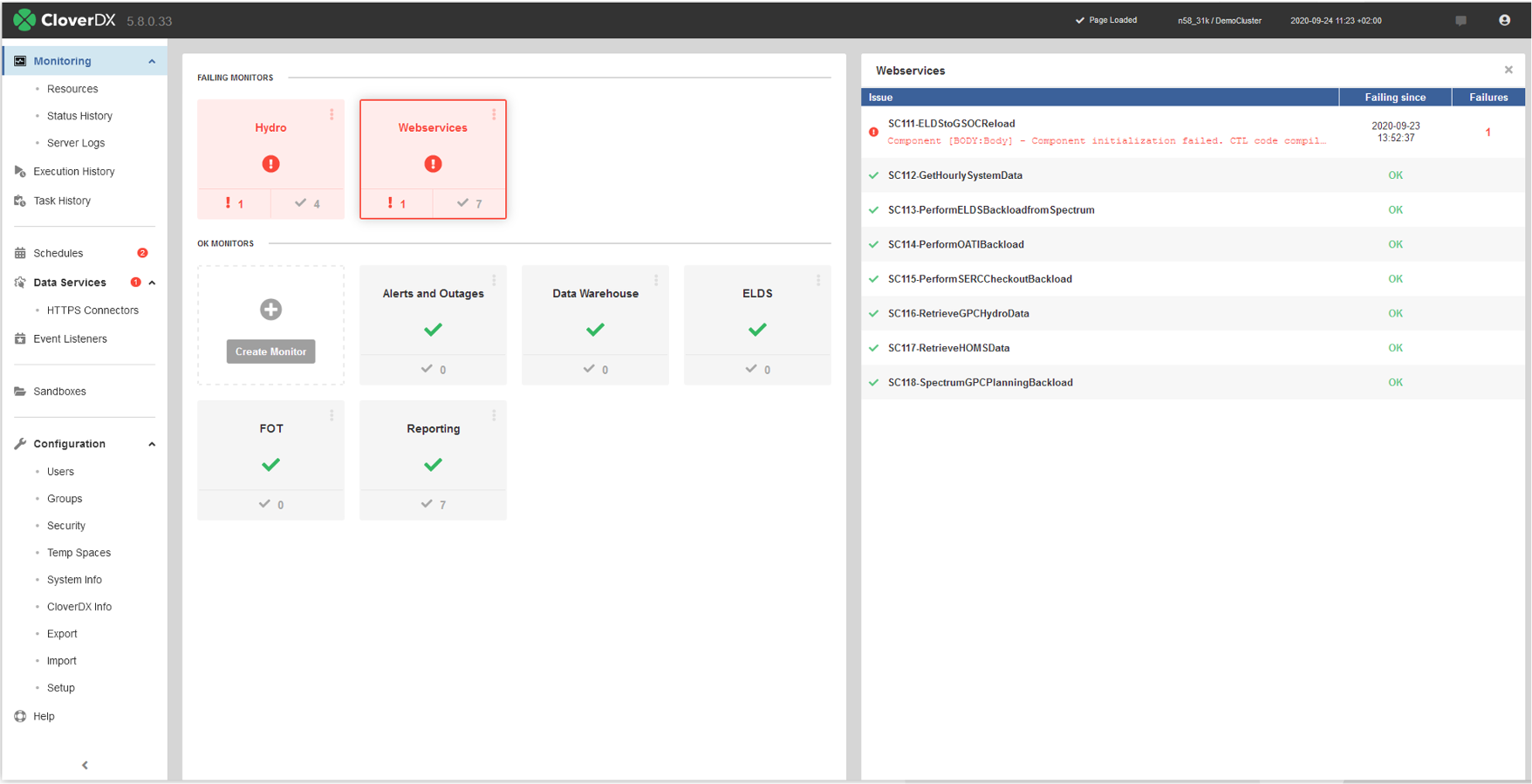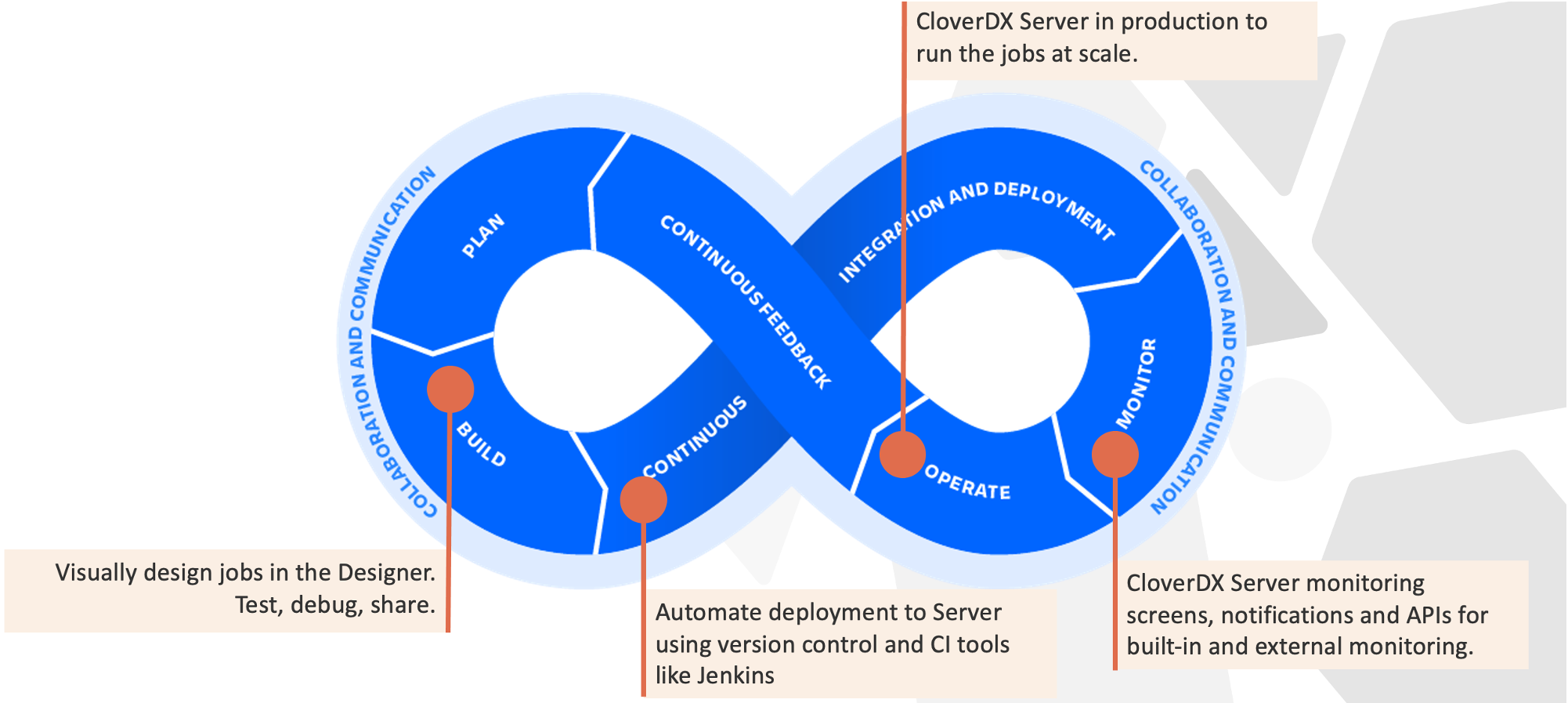When applying the DataOps methodology to your data lifecycle, it's not just a good mindset and a set of best practices that will stand you in good stead; you'll need the right toolkit too.
Your business needs to deliver data value as quickly and reliably as possible.
Here’s some key ways CloverDX can help you embrace DataOps to do just that.
 Where CloverDX sits in the DevOps and DataOps process
Where CloverDX sits in the DevOps and DataOps process
1. True agility
With modern data tools allowing you to transfer the agile approach of software development into the world of data, you can now benefit from shorter timeframes for delivering valuable insights and gaining competitive advantage. We’re talking weeks or less here, not the months you may be used to.
CloverDX can help you streamline various data processes and bring your teams together, enabling you to quickly build, reiterate and improve your data processes.
More specifically, CloverDX helps you deploy your code faster and more frequently:
Build and adapt faster
- CloverDX’s visual interface and ability to package, share and reuse components helps you build projects more quickly
- A shared platform enables better cross-departmental collaboration and common understanding
- Building data quality and error handling into your process not only helps improve your data quality but also helps automate testing
- Integration with CI/CD tools for automated deployment of your data jobs
2. Collaboration and data understanding
DataOps, though primarily handled by data engineers, requires the expertise of business-led domain experts (a key difference between DataOps and DevOps). As a result, communication to ensure any DataOps project is fit for your business requirements is crucial.
Easier business and dev communication
CloverDX provides the foundation for this collaboration:
- Visual design enables people on both the business and technical sides of the business to speak the same language – non-technical people don’t have to try and understand vast amounts of raw code
- Documentation provides transparency of processes and definitions
- The ability to deliver fast insights means business stakeholders can provide feedback more quickly
- This helps eliminate silos of information and achieve the DataOps goals of delivering fast, reliable data.
The video below is packed with advice on how to destroy data siloes. With insight from industry experts from Snowflake and Western Union, this is tangible advice from those working on the front line with data.
Making data accessible
Enabling people across the business to work with your data is the ultimate goal of a DataOps approach.
The Data Catalog functionality enables IT teams to make prepared, live data accessible to business users on-demand. Rather than having to request data repeatedly from the IT team, non-technical users can access that data themselves, whenever they need it - making it faster for everyone across the business to get the insights they need.
CloverDX’s Data Apps enable you to build user interfaces to allow non-technical people to interact with data jobs, and with Data Services functionality you can publish and collect data over API to connect applications and storage.
If you have other BI or visualization tools within your DataOps toolkit, CloverDX can integrate with them to provide a regular, reliable stream of data.
3. Automation wherever possible
The key with DataOps is to automate as much as you can. You need to build, test, deploy, monitor and iterate quickly, and automating as many steps as possible speeds up both the process and the time to value.
CloverDX helps you automate many of the key steps, from building your data processes, to testing, releasing, deploying, operating and monitoring them.
- Data quality. DataOps encourages the automation of data quality so that you have continuous monitoring and validation. This provides instant feedback on both code quality (whether something new has broken something else) and data quality (whether there’s suddenly a problem with your source data)
- Data anonymization. In order to achieve the data quality promise above, you’ll first need to define automated tests, such as data validations or code tests. However, to run code tests, you need to gather a test data set. Oftentimes, you won’t be able to use your ‘real’ data due to privacy or volume concerns; instead, you’ll have to generate a test set, ideally by anonymizing your original data.
- Data integration. Once you've mapped your data, CloverDX allows you to automate all your integrations with the click of a button.
- Event triggering. Automate a data job after a key trigger (for example, when a file is placed in a certain folder) to avoid manual, time-consuming processing tasks.
- Data reporting. Once your insights have been gathered, ensure your data reports are automatically delivered quickly to the people who need them most via email or a web interface.
Continuous Integration with CloverDX
CloverDX isn’t a CI tool, but works very well with tools that are (such as Jenkins, CircleCI and version control tools). The outputs from CloverDX Designer are xml files, giving you flexibility to integrate with your existing tech stack and help fully automate the process of getting your data jobs to production.
Automated monitoring and operation
CloverDX Server gives you one place to monitor all your processes and automate error notifications to keep things running with little intervention.
Ultimately, automating these steps will streamline your DataOps processes and bring you higher data quality and integrity.
4. Easy to maintain and extend
The DataOps approach of a continual deployment and feedback loop means you need to be able to adapt what you have quickly and easily.
So, how does CloverDX help with this?
- CloverDX Designer ensures your data processes are easier to understand (and fix) than complex code, making them maintainable by everyone – not just the one person that wrote the code
- The ability to package and reuse ‘building blocks’ makes it easier and faster to update and change your processes
- CloverDX incorporates into your existing technology stack, integrating with other DataOps tools (such as CI/CD tools)
- CloverDX Server gives you one place to monitor everything running in production, increasing reliability, and trust from users that the data they’re using is accurate

The CloverDX Server Operations Dashboard to monitor all your business processes
CloverDX's DataOps philosophy
A DataOps approach gets value delivered to your business as quickly as possible. It requires good communication, an agile development approach and a fast path to production.
CloverDX enables DataOps by helping you:
- Speed up development of data projects
- Bridge the communication gap between business and technical teams
- Automate your data pipelines
- Run data jobs at scale
- Integrate your existing tools and processes
How do you get to DataOps maturity?
While a fully automated DataOps process might be the goal, where do you start?
Our advice on embracing DataOps: start automating.
Automation is the key to DataOps and to delivering value quickly. So either from the development side or the production side (or in parallel), the more you can automate – without the need for people – the closer you get to the ideal. And any piece of the process you can improve, the closer you move.
To learn more about how a DataOps approach can improve the effectiveness of your teams, watch our webinar: Starting Your Modern DataOps Journey
Driving innovation with data
DataOps is a crucial part of driving innovation with data. It enables you to develop and deliver faster, helping your organization to experiment and scale quickly.
In the video below, CloverDX Global Solutions Director Jay Benedetti shares some examples of what effective innovation in data looks like, including an example of how a data strategy was able to evolve to support a changing business strategy and ultimately drive growth. We helped this global organization automate their entire DevOps and deployment strategy in Azure, leading to far better scalability.
(Editor's note: page updated as of June 2020.)









